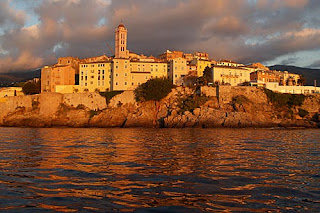Trevallon is located in the heart of Provence in Saint-Etienne-du-Grès, in the Bouches-du-Rhône, 25 km south of Avignon and 7 km west of Saint-Rémy-de-Provence (beautiful village), on the northern slopes of the Alpilles. The vineyard covers 17 hectares: 15 hectares of red grapes, made up of equal parts of Cabernet Sauvignon and Syrah. Plus 2 hectares of white grapes, 45 % Marsanne, 45 % Roussanne and 10 % Chardonnay.
Trevallon is a pretty recent domaine and when Eloi Dürrbach wanted to plant vines he had to use dynamite to break the rock. During the '73 , Eloi was able to plant his first 3 hectares of vines. The 1st ever Trevallon was produced in 1976, a great year since this is my birth year :-)
Cabernet sauvignon and syrah are not very common in Provence even though Jules Guyot in his famous "Etude des vignobles de France" says that Cabernet Sauvignon used to be grown in Provence before the phylloxera crisis and that, blended with Syrah, it could produce excellent wines.
The whites grapes are grown on the north-facing slopes allowing to keep acidity and therefore freshness in the wines.
Because in 1993 the INAO required a maximum of 20% of cabernet in the Baux de Provence AOC, Trevallon was forced to the Vin de Pays AOC (Bouches-du-Rhône). Tough to swallow when you're making one of the best wine in the region...
Eloi point of view in the growing and winemaking is what I admire:
-the soil is nourished organically and ploughed
-No pesticides, insecticides, only sheep manure
Only native yeasts are used and acidity is never corrected. Wine is either punched down by foot or pumped-over.
Red wines are raised in barrels for 2 years and 1 year for the whites which are never racked. Lees are not stirred as Eloi believes it brings too much richness to the wine.
 In 1996, Eloi asked his father, an artist, to design labels, different each year and reflecting the profile of the wine in this particular vintage.
In 1996, Eloi asked his father, an artist, to design labels, different each year and reflecting the profile of the wine in this particular vintage.
The 1999 Trevallon Blanc was an outstanding wine. Golden color. This is drinking so well right now. Enticing nose with rich spicy honey mixed with apricot. Throw in the mix a floral touch, light almond and a wax sensation as well and you have a very complex nose. Based on the nose, you would almost expect the wine to be sweet but this is totally dry of course. Full body and fat, low acidity but amazingly this is never heavy or cloying. Instead, you simply can not stop drinking this wine. It coats your palate with again this honey but also a nice and refreshing citrus note plays with the apricot and almond. Really a great wine with a very strong white Hermitage profile. I'm impressed.
 The 2006 Trevallon Blanc was very similar except for a lighter color. The nose is a treat with great complexity: lemongrass, honeysuckle, honey, licorice...Full body but really balanced, could not pinpoint one particular fruit on the palate. Wine coats your mouth with additional light butter notes on the finish. Even the wine is fat, there's enough acidity to keep you drinking it...
The 2006 Trevallon Blanc was very similar except for a lighter color. The nose is a treat with great complexity: lemongrass, honeysuckle, honey, licorice...Full body but really balanced, could not pinpoint one particular fruit on the palate. Wine coats your mouth with additional light butter notes on the finish. Even the wine is fat, there's enough acidity to keep you drinking it...I want to revisit this wine in 7-9 years.
Very interesting to compare both vintages. The 99 is really similar to any good white Hermitage and the 2006 is more Provencal, at least for the moment. 7 years apart and without any question some similar characteristics.
Trevallon is one of the few wines that I buy every vintages as I have total faith in those bottles.
Long life to the king !













